|
Perspective
By Rich Checkan
I trust everyone had a wonderful Independence Day celebration last week… spending quality time with family and friends. I left Bethany Beach in Delaware on the 4th of July with my wife Helen and my son Thomas. We packed our bags and headed down to Boca Raton, Florida.
Our destination was Rick Rule’s Natural Resource Symposium. Today is our last day of what has been an excellent conference.
Regular readers of Information Line know my message down here…
Gold at all-time highs is dirt cheap.
Silver at 60% of all-time highs is even cheaper.
As it turns out, I am not alone in my beliefs. That theme was echoed repeatedly throughout this past week. And I believe it will be repeated for some time into the future as well.
But the short-term picture for gold and silver is not all rainbows and unicorns…
Healthy Profit-Taking
Last Friday, as we flew down to Boca, a disappointing labor report convinced investors once again that Federal Reserve Chairman Jerome Powell and the Open Market Committee would cut interest rates.
The thought that the economy was showing signs of cracking led investors to anticipate anywhere from one to three rate cuts by the end of the year. Here at the conference, I have heard the first rate cut would come as early as July, while others think September makes more sense.
Still others believe there will be no rate cuts at all in 2024.
Investors ran gold and silver prices up on the news last Friday. Then, profit -taking brought the price back down a little at the beginning of the week.
Some investors dislike the profit-taking pullback. I love it.
Glen and Michael always preached to me the importance of healthy, stair-step price appreciation. We love seeing surges and dips in a bull market. We love seeing new, higher highs and new, higher lows.
A market like that can sustain growth for a long time.
Conversely, price spikes are not typically sustainable, and they tend to fall as quickly and as deeply as they initially climbed.
I will take a slow, steady rise over a hyperbolic spike every day of the week.
Who Is In?
There is really no change to who is buying into this market… sort of.
Mainly, it is Central Bank buying that has supported the gold price over the past few years. That has not changed.
Central Banks continued their buying in the first quarter… surpassing last year’s record buying pace. As we wait for second quarter figures, we see continued interest from Central Banks, with the notable exception of China.
Last month, China announced it had not made any Central Bank purchases in May. This month, they claim no Central Bank purchases for the second straight month.
Yet, there is no fall-off in Central Bank purchases. The other Central Banks have clearly picked up the slack.
Add to that, Asian retail buying and buying by family offices as they prepare their portfolios for what will no doubt be a vicious presidential election cycle.
Who Is Out?
No question. No change. The western investor is either sitting on the sidelines or selling liquid gold and silver assets to pay down debt… most likely from credit cards.
We can see the liquidations at the retail level. We can also see the drawdown in Exchange Traded Funds (ETFs) in both Europe and North America. At times, I actually think I can hear the giant sucking sound as gold and silver investors exit their positions.
The end result is the biggest migration of real wealth (gold and silver) from West to East that I have experienced in my three decades in this industry.
The East is getting richer with real assets.
The West is getting poorer… buried in debt and claims on real assets.
Take Action During the Summer Doldrums
When the Western investor gets into this market, we expect things to get very interesting. But that is not the case just yet.
And we are entering into a period where gold and silver prices tend to stagnate. Many people are focused on surf, sand, and vacation. Chinese investors are well past Lunar New Year buying. Indian investors are nowhere near wedding season buying.
Prices tend to be flat over the next couple of summer months.
That spells opportunity…
- Gold is dirt cheap at all-time highs.
- Silver is even cheaper at 60% of all-time highs.
- Prices are expected to be stagnant for a month or two.
- Premiums have not started to rise yet on fabricated coins and bars.
This is a great time to buy!
Unfortunately, many investors will continue to wait. They will hope for a significant dip in prices. They have bought into the mainstream narrative that current prices for gold and silver are high.
Those investors will be kicking themselves before very long.
If your goal is to Keep What’s Yours, buy gold and silver now.
Buy on our website directly… www.assetstrategies.com. Call us at 800-831-0007. Or, send us an email.
OR… hold off and buy the more expensive gold and silver later. You know what to do.
Got Gold?!?!
—Rich Checkan
Editor's Note: Jeff Havenstein is a senior analyst for the Retirement Franchise, headed up by David “Doc” Eifrig. This article was originally published in Health & Wealth Bulletin on June 12, 2024. Click here to subscribe.
Feature
Things Don't Feel Great in America
By Jeff Havenstein
Everyone wants you to think America is booming...
On the surface, it is. A new report from the Federal Reserve just confirmed that our net worth is at all-time highs.
When you think about what really drives our wealth, it comes down to two things: stocks and real estate. This is what the average American relies on for their financial well-being.
In the first quarter of this year, the value of equity holdings increased by about $3.8 trillion. The S&P 500 is right around all-time highs as I (Jeff Havenstein) write. Also, the value of real estate held by households rose about $900 billion to a record high.
In total, household net worth rose to $160.8 trillion earlier this year – a 3.3% increase from the end of 2023.
The chart below shows household net worth by each generation. Take a look...
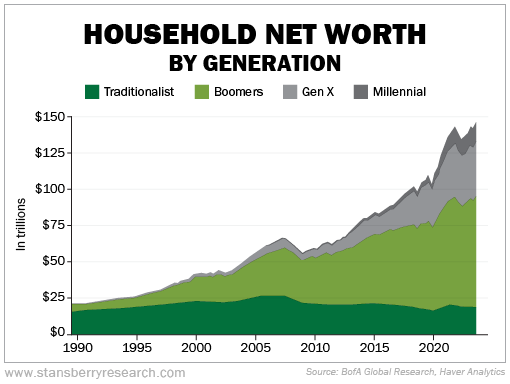
Boomers are the richest they have ever been. And younger generations are catching up as well.
You might think that it's a great time to be an American.
Well, not exactly...
Think about your own experiences. Things just don't feel that great in America today.
Did you know the average American today says they need to earn at least $233,000 a year to be comfortable? That's a far cry above the national average salary of $60,000.
Meanwhile, nearly two-thirds say they don't feel financially secure. Granted, lots of folks are to blame for their own financial woes. For too many Americans, their only "investments" are flat-screen TVs, car payments, and expensive vacations.
Life is expensive today. There's no other way to put it...
Chocolate bars, mayonnaise, and a loaf of bread all cost about 50% more than they did in 2019. The price of sugar is up by about 125%. Even the price of orange juice is up more than 250% since 2019.
It's not just everyday essentials, either. Health care is brutally expensive. And if you're saving for your kids or grandkids to go to college, you know what an uphill task that is. In 1980, the price to attend a four-year college was $10,231 annually. In recent years, the price has skyrocketed to $28,775 annually.
And having two young kids myself, don't even get me started on the price of childcare. According to Bank of America, the average childcare payment per household rose more than 30% between 2019 and 2023. The average family spent more than $700 per month in September 2023. (Here in Baltimore, we'd be ecstatic to just spend $700 per month.)
I'm going to show you one more chart to prove that things aren't as rosy as they seem. While household net worth is at all-time highs because of a strong stock market, high cash yields, and rising real estate values... you still have to consider inflation.
When you adjust net worth for inflation, you'll see household wealth remains below its 2021 peak...
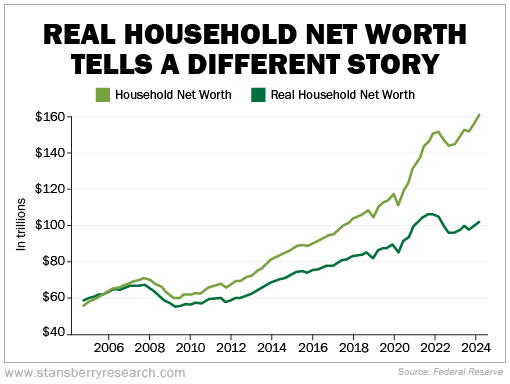
We're at an interesting moment in time for anyone in retirement or preparing for it.
Given the risks that our research team sees in the market, you have to be careful how you invest your nest egg moving forward. It's clear that you need to earn a return on your investments that beats inflation – and you need to minimize risks.
This means turning to assets that diversify your portfolio... something Dr. David "Doc" Eifrig has been preaching for a long time.
Editor's Note: Frank Holmes is the CEO of U.S. Global Investors —a company that produces quality analysis concerning gold, precious metals, natural resources, and emerging markets—in conjunction with his work as a fund manager. Frank is a long-time friend of ours, and we've chosen to share his article originally published July 5, 2024. For more articles like this from Frank and other leading experts, you can subscribe to the U.S. Global Investors newsletter here.
Hard Stuff
Commodities Halftime Report: Silver, Oil And Gold Were The Top Performers
By Frank Holmes
If you were in charge of feeding everyone this Fourth of July, you probably noticed a hike in prices.
According to the American Farm Bureau Federation, the cost of a typical Independence Day spread for 10 people jumped to $71.22 this year, up 5% from last year and a whopping 30% from five years ago.
That may not seem like much, but this inflation has a compounding effect on commodities. Research from Goldman Sachs shows that a 1 percentage point increase in U.S. inflation has historically led to a real return gain of 7 percentage points for commodities. Meanwhile, the same trigger caused stocks and bonds to decline by 3 and 4 percentage points, respectively.
This data supports the potential of commodities as an inflation hedge. In times of rising prices, having exposure to tangible assets like silver, oil and gold often retain their value better than paper assets.
The reason I mention silver, oil and gold is because they were the top performing commodities in the first half of 2024. Let’s dive into what’s driving these trends and what they might mean for investors.
Silver’s Fourth Year Of Market Deficit Could Spell Opportunity
Leading the charge is silver, up close to 22.5% in the first half. The “poor man’s gold” is proving its worth, driven by a global supply deficit and increasing demand. Back in January, the Silver Institute forecasted that global silver demand will reach a near-record 1.2 billion ounces in 2024, up 1% from last year. This growth is primarily fueled by industrial applications, particularly in the booming solar energy sector.
We’re looking at the fourth consecutive year of a structural market deficit in silver. The deficit is expected to widen by 17%, reaching 215.3 million ounces. Loyal readers should be aware of what happens when demand outstrips supply—prices tend to rise.
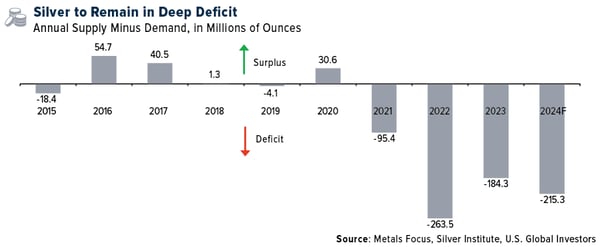
The Coming Oil Glut?
Oil, our second top performer with a gain of 13.8%, continues to demonstrate its staying power in the global economy. Despite the push for electrification, oil demand remains robust.
According to a new report by the International Energy Agency (IEA), we’re approaching a significant turning point. Global oil demand, which averaged just over 102 million barrels per day in 2023, is expected to level off near 106 million barrels per day towards the end of this decade. This plateau in demand coincides with a projected surge in global oil production, particularly from non-OPEC+ producers.
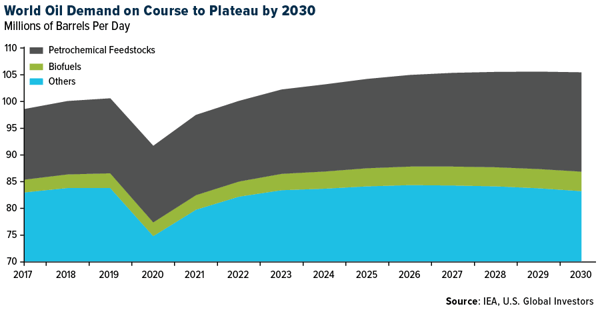
The implications of this forecast are profound. We’re looking at a future where oil supplies could reach levels of abundance unseen outside of the pandemic. This potential oversupply situation could exert downward pressure on oil prices.
It’s worth noting that the IEA’s outlook contrasts with some other forecasts. Goldman Sachs Research, for instance, expects oil demand to continue growing until 2034, potentially reaching 110 million barrels a day. They cite increasing demand from emerging Asian markets and the petrochemical industry as key drivers.
Goldman Sees $2,700 Gold On The Horizon
Last but certainly not least is gold. The yellow metal has shone brightly in 2024, rising 12.8% year-to-date and outperforming many major asset classes. This performance is particularly impressive given the high interest rates and strong U.S. dollar—conditions that ordinarily create a challenging environment for gold.
What’s behind the metal’s resilience? It’s a perfect storm of factors: continued central bank buying, strong Asian investment flows, steady consumer demand and persistent geopolitical uncertainties. In its midyear outlook, the World Gold Council (WGC) estimates that central bank demand alone contributed at least 10% to gold’s performance in 2023 and potentially around 5% so far this year.
Looking ahead, Goldman has set a bullish target of $2,700 per troy ounce for gold by year-end. That’s an increase of about 16% from current levels. They cite solid demand from emerging market central banks and Asian households as key drivers.
Many investors, myself included, appreciate gold’s potential as a hedge against both inflation and geopolitical risks. It could provide a buffer against potential stock market volatility, especially if trade tensions escalate. Additionally, gold might see further upside if concerns about the U.S. debt load increase or if there’s a shift in Federal Reserve policy under a new administration.
As we move into the second half of 2024, the commodities market continues to offer intriguing opportunities. Silver’s industrial demand, particularly in the green energy sector, presents a compelling growth story. Oil remains a critical resource, especially for emerging economies, despite the global push towards renewables. And gold, the eternal safe haven, continues to prove its worth in uncertain times.
Gold Market
This week gold futures closed the week at $2,397.60, up $58.00 per ounce, or 2.48%. Gold stocks, as measured by the NYSE Arca Gold Miners Index, ended the week higher by 6.27%. The S&P/TSX Venture Index came in up 2.80%. The U.S. Trade-Weighted Dollar fell 0.95%.
Strengths
- The best performing precious metal for the week was silver, up 6.60%. Montage Gold announced their 2024 short-term incentive plan which highlights the aligned interests of the management and the shareholders to drive forward the Koné project’s construction and development. Compensation is dependent on rapidly achieving stated milestones to put Koné into construction in the first quarter of 2025, according to Stifel.
- West African Resources seeks to raise A$120 million via a single tranche placement at A$1.37 per share, according to the Australian Financial Review (AFR). Citing a term sheet, the AFR reports that funds raised will go towards funding construction of the Kiaka gold project, mining pre-production capital, exploration programs and working capital. Total proceeds of A$150 were secured as the placement was heavily oversubscribed.
- Central banks, led by Turkey, China and India, put a floor under the gold price in the face of outflows from exchange-traded funds (ETFs) in the recent past. The sector uses gold as a dollar-diversification play, making it popular in nations with large U.S. currency holdings. China bought the metal for 18 months straight before pausing in May, according to data from the International Monetary Fund (IMF). China’s pause in purchases may just be from buying their gold from international markets. Fred Hickely of the High-Tech Strategist newsletter noted that China did indeed buy gold, but it was sourced from domestic production.
 Weaknesses Weaknesses
- The worst performing precious metal for the week was gold, but still up 2.48%. Costco reported their first delivery of 100-gram gold bars this week, but they sold out in less than a day. The gold bars fetched $7,599.99 each. Calidus Resources has collapsed with its main financier, Macquarie, calling in receiver Korda Mentha. It remains unclear why Macquarie called time on the company, which runs the Warrawoona gold mine near Marble Bar, according to Canaccord.
- Endeavour Mining says it is studying the damage from the leak of poisonous liquid at its second-biggest mine located in southern Ivory Coast. Early reports show that a broken valve leaked 3,000 liters of mud containing cyanide into a canal within the perimeter of the mine, according to Bloomberg.
- According to BMO, Ascot Resources has faced commissioning challenges throughout its processing plant, particularly in the areas of the elution circuit boiler, carbon management, thickener flocculation and metallurgical sampling and estimation. These issues have slowed production and sales below expectations. Additionally, global supply chain challenges and limited vendor support have caused some delays. There is likely a capital shortfall that will need to be addressed in the near term.
Opportunities
- Excessive government spending in the U.S. and geopolitical uncertainty are underpinning calls from some investor heavyweights to buy gold as a hedge against sovereign debt risks. Schroder Investment Management and UBS Global Wealth Management are bracing for a rocky second half, and gold has emerged as a preferred trade to navigate the volatility, according to Bloomberg.
- Citigroup expects rising investment demand to absorb almost all gold mine supply over the next 12-18 months, it said in a report. That underpins the bank’s base case for a price of $2,700-$3,000 an ounce during next year.
- Canaccord views the Red 5-Silver Lake merger as logical with clear benefits for both companies, namely absolving Silver Lake’s relatively short mine life overhang, and rectifying Red 5’s single asset exposure and net debt position. Red 5’s large reserve base and Silver Lake’s strong balance sheet marry neatly, giving the enlarged entity the opportunity to aggressively pursue internal optimization initiatives as well as potential inorganic opportunities.
Threats
- According to Mining.com, the Ivory Coast is planning to revise its mining code to increase state profits, the country’s mines minister Mamadou Sangafowa Coulibaly said on Monday. The country is seeking to develop its long-neglected mining sector to diversify its income sources. The west African country’s mining code was last revised in 2014.
- According to BMO, Ascot Resources’ cash balance at the end of the second quarter was C$12 million, representing a decrease of C$35 million since the first quarter. Additionally, Ascot reported that it has received a waiver for non-compliance with the covenants set forth in its financing package, which is due to expire on July 31, 2024.
- Bloomberg reports that Vale Base Metals has chosen Sean Usmar as its CEO. Sean Usmar founded Triple Flag Precious Metals in 2016 and currently serves as the company’s CEO and director. Sources within the article note that the selection is not yet confirmed and “it’s possible things could change.” As of the end of the week, there appears to be no confirmation on the rumor.
Editor's Note: Nomi Prins is a best-selling author, financial journalist, and former global investment banker. Prinsights Pulse is a new, free publication that’s curated by Nomi Prins. Designed for everyone from executives at large institutions to individuals seeking to enhance their financial understanding, this powerful newsletter provides essential insights into economic trends that affect us all. This article was originally published on July 10, 2024. Click here to discover more of Nomi's insights.
The Inside Story
The Hidden Drivers Behind Gold’s Next Rally
By Nomi Prins
“Gold is money. Everything else is Credit.” J. P. Morgan’s Testimony to Congress in 1912
I spent months researching the Morgan family while writing my book, All the Presidents’ Bankers. My examination included digging into the visitor records books that are over 100 years old at historic Jekyll Island, located along the southeastern coastline of Georgia.
That’s where, under the guise of a “duck hunt” back in November 1910, a meeting took place between four banking executives, a Rhode Island Senator and an Assistant Secretary of the Treasury in what would turn out to be the start of the Federal Reserve system.
And while J.P. Morgan wasn’t there, he was a member of the Jekyll Island Club. As it turns out, nobody from the group were members – but they were rumored to have used his connections to access the exclusive club.
In the years that followed, the Federal Reserve changed the nature of money. Along the way, gold went from backing the U.S. dollar, to the standard against which the U.S. dollar was measured, to unmoored from the U.S. dollar by decree of the Nixon Administration in 1971.
Recently, gold has experienced a renaissance in its modern role as a U.S. dollar diversifier.
Here’s how…
Today, central banks hold about 17% of all gold ever mined. The Federal Reserve owns more gold than any other central bank. Germany comes second, and Italy is third.
Yet, the acceleration in gold purchasing is being led by emerging nations, including China, India and Turkey. Recently, over the course of 18 straight months, the People’s Bank of China steadily increased its gold purchases. That was one of many factors boosting gold’s value.
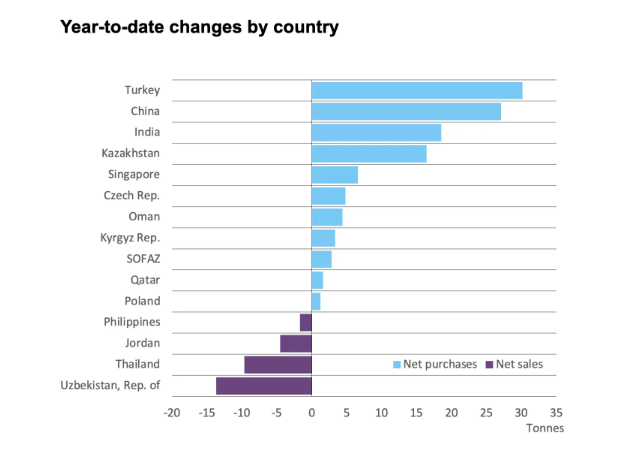
Other reasons were for this trend include lingering inflation, geo-political uncertainty, and anticipation about the Fed cutting rates, which has historically catalyzed higher gold prices.
Gold’s steady rise was derailed last month following reports that China’s central bank had taken a month breather, which continued over the last month. What you should know is that this 2-month pause is a meaningless blip in its buying streak.
Below, I’ll detail why…
But first, let me express my excitement at kicking off the Rule Natural Resources Investment Symposium this week for the third year in a row! The event is hosted by Rick Rule who is one of my investment heroes and a great human.
The topic of my speech was The Real Asset Big Bang.

I’ll share more takeaways here at Prinsights Pulse soon. The bottom line is that the Fed is becoming less relevant as gold and other real assets gain traction. And though the U.S. Dollar isn’t going away any time soon, where and how it’s used is changing.
The Gold Trend Up Trend
The World Gold Council (WGC) just released a new survey of central banks. A record 81% of the 70 central banks that responded said they expect their gold buying to increase in 2024 overall. That’s up from 70% at the same time last year. In fact, 30% of them expect to add gold reserves over the next year.
Central banks buy gold to offset exposure to the Dollar, risks from U.S. banking policy and any fallout or concerns that remain with inflation.
The more they diversify their U.S. Dollar holdings to gold-based ones, the more that occurs.
Last year, central banks bought 1037 metric tons of gold in comparison to a record 1136 metric tons in 2022. The People’s Bank of China lead the buying.
Turkey, China and India comprised most of the Q1 2024 gold buying. The strong start signals central bank demand will grow in 2024.
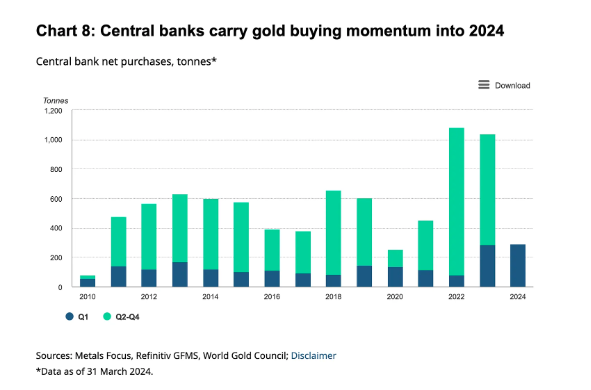
So far this year, the price of gold in U.S. Dollar terms has jumped by 19% to an all-time high of $2,450/oz. in May. It is up 24% in comparison to this time last year.
The Other Side of the Gold Coin? People
Of course, there are other factors beyond central bank buying and Dollar diversification that are bolstering gold prices. Retail buying is growing worldwide due to skepticism about banks and central banks.
Last March, gold prices leaped by 8% in the weeks following major U.S. bank failures at Silicon Valley Bank and Signature Bank.
I was traveling in Australia at the time, meeting with gold, uranium and other mining CEOs and visiting mine sites. I also visited the Perth Mint. It contains some of the purest-grade physical gold bars on the planet.

What I learned was that people who had never bought gold before – on the other side of the world – wanted to accumulate a wealth-preservation, inflation-hedging asset outside of the U.S. banking system. This retail buying augments central bank buying.
Which brings us back to China. For all the bruhaha over China’s slower pace of gold buying, Chinese retail buyers didn’t miss a beat.
Chinese gold ETFs grew by RMB1.8bn (U.S. ~$246 million) in May. Inflows rose for the sixth month in a row – to a new record high.
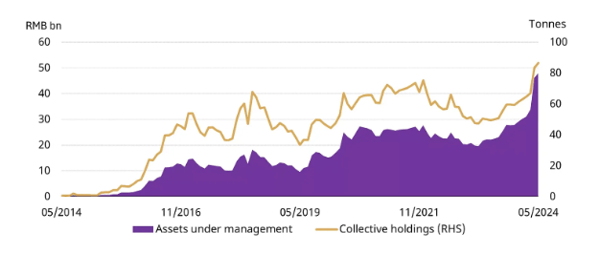
Meanwhile, U.S. and other retailers from around the world paralleled this buying. The trend even showed up in The New York Times in April when it reported how customers were flocking to, of all places, Costco (known for $1.50 hot dogs) to purchase gold bars and silver. In fact, it was reported that the warehouse retailer sells $200 million worth of gold and silver each month and sells out within hours according to the Wall Street Journal.
Rising Bank Risk to Elevate Gold Prices?
The final prop for gold is Wall Street. The U.S. banking system is flashing warning signs.
Commercial real estate (CRE) loan delinquencies rose at paces last seen before the 2008 financial crisis. Regional banks, where these loans are concentrated, remain increasingly at risk.
The Fed and the FDIC cited JPMorgan Chase, Goldman Sachs, Bank of America and Citigroup as showing “weakness” in their living will or emergency derivative strategies. All at a time when the OCC continues to signal that the four largest banks hold 87.6% of the total banking industry’s notional amount of derivatives.
Problematic derivatives and subprime loan failures led to big bank bailouts in 2008.
During times of financial instability, investors seek safe haven assets like gold to protect wealth against potential bank risks. We saw this when gold rallied in the wake of the 2008 financial crisis and after the Covid pandemic.
To protect yourself against banking system risk and follow the central bank gold buying trend, consider investing in the IAU ETF. It has lower charges than other gold ETFs while holding a mix of real gold and gold miner stocks.
|











